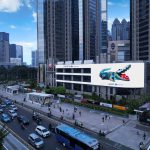By Remi Roques, General Manager Broadsign APAC
Static Out of Home (OOH) signage is one of the oldest forms of advertising, tracing its origins back centuries. Unlike digital or online advertising, which have both gained prominence in recent years, static OOH advertising relies purely on physical displays to catch the eye of passersby. Throughout its journey, static has remained a strong presence and continuously delivered results, so it is no surprise that it’s still an essential part of the modern marketer’s toolkit.
Static OOH inventory can be found everywhere! We see static billboards and posters across roads and freeways, in and around cities and transit stations, bus stops and buses, shopping centres, cafes, stadiums and arenas, movie theaters, and more. The static format often offers high-impact visibility in strategic locations in nearly every country across the globe, making it hard to ignore and delivering high levels of exposure to pedestrian and road traffic.
As brands today experiment more and more with incorporating OOH into multi-channel campaigns and work to achieve more sustainable business practices, most modern media owners are focused on promoting their digital offering and the capabilities of digital for more dynamic ad execution, convincing brands to engage their audiences in more interactive and impactful ways heavily promoting anything. But, what they may not realize is the value of static, especially in the digital era in which we live, cannot be ignored.
Static continues to thrive.
Late last year, Broadsign conducted a survey and recently released the findings in our State of Static OOH report (the full report is available to download on our website). We surveyed over 125 media professionals across 60 OOH companies around the world.
More than two-thirds of the static OOH media owners we surveyed offer brands a mix of static and digital advertising inventory. We expect this number to grow as most respondents also noted plans to transform their static screens into digital ones in the next few years.
Whileigital inventory is attractive to media owners for its ability to provide ad placements that are more dynamic and data-driven, the most effective strategies combine both static and digital media. In an increasingly digital world, static still holds its own for unrivalled visibility, cost-effectiveness, long-term exposure and 100% share of voice, which is why many brands still love and leverage it across campaigns.
Static OOH represents about 70 percent of today’s global OOH inventory, making it the most dominant format in today’s OOH ad business.
Creativity in Static
In terms of messaging and creative effectiveness, the simplicity of a static advertisement allows for clear, concise messaging, complementing a digital campaign where images and colour can further extend brand’s message. At the same time, static can still leverage technology in innovative ways. QR codes, for example, can be included in static ads, providing a call to action and allowing pedestrians to interact with the ad via their mobile phones. It increases the ad’s effectiveness, engagement and measurability.
Static presents challenges
With the pros come the cons. Media owners must manage static expectations as advertisers expect fast turnarounds, and the ability to make last-minute changes and creative executions. Poster installer teams face some of the biggest hurdles in our industry and are the most impacted in the media owner organisations. The media vendors we partner with say that the management of static OOH forms is one of the biggest challenges.
Static workflows also largely remain manual with little to no automation. Over 37% of media owners manage their business with spreadsheets and slides; it is time-consuming, unproductive, and costly. In addition, 53% of media owners think operational efficiencies prevent them from growing their revenue.
Managing inventory availability, compiling client campaign proposals, organising bill posters’ schedules and creating Proof-of-Performance (PoP) reports are largely done by hand. These tasks are time-consuming and part of outdated processes. As an industry, how could we do better?
I’ve learnt that although most of the challenges around static OOH vary per media owner, effective campaign management software is needed to help solve the most significant hurdles.
Technology advancement for Static OOH
Static management tools benefit every business owner and department. Incorporating additional automation into processes and tasks relating to client proposals, posting processes, and post-campaign reports for static OOH ads helps increase business reactivity, revenue, and profitability.
Unsurprisingly, our survey found that 87% of media owners believe there is still room to automate their regular tasks and workflows. According to the report, real-time availability dashboard was cited as the top feature media owners look for in a static OOH management tool, followed by operations management and proposal building.
A static OOH management tool can provide real-time inventory availability, effective charting, proposal building, account management, operations management, design and delivery tracking, to name a few. With more and more media operators offering static and digital OOH inventory, a single platform for seamless management is in high demand.
Like every other medium, static reflects a broader shift towards sustainability and environmental responsibility across industries. Energy-efficient LED lights and recycled vinyl or paper posters are key trends and innovations for a greener future.
What the future holds
Despite the rapid advancements in digital technology and the rise of digital out-of-home (DOOH) advertising, static OOH holds its ground, due to its ability to create lasting impressions, offer constant visibility, and reach a broad demographic.
Media owners expect data-driven targeting, data measurement, and attribution technologies to change the growth of static OOH in the coming years.
The resilience of Static OOH lies in its simplicity and reliability. Its resilience and relevance are built on high impact, broad reach, and prolonged exposure. To be clear, however, I’m not advocating for one over the other. The combination of the two will ultimately yield the best results. .
If you want to know more about our survey findings from our State of Static OOH, click here to download the full report.
MARKETING Magazine is not responsible for the content of external sites.











